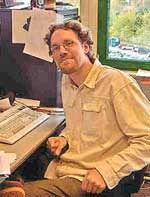
Michiel Min is a research student at the Astronomical Institute, University of Amsterdam, who carried out much of the data analysis behind the current ESO release, see: Ingredients are There to Make Rocky Planets. Michiel was able to talk with Universe Today in between his studies.
Universe Today: Do your findings help to explain the origin of our own solar system in better detail?
Michiel Min: The timescale of planet formation is still under debate. Our findings provide evidence that the small dust grains are already growing after a billion years. Our observations do provide a unique view of the building blocks of planets. It is clear from our findings that the building blocks of Earth-like planets, close to the star, are crystals (crystalline silicates), while the building blocks of the planets further out, are amorphous silicates. Also we see that the growth of dust grains seems to go easier closer to the star.
Have your observations provided an answer as to how these planetary systems around giant stars may have formed?
The main reason that only giant planets in close orbits have been found has to do with the way of detecting these systems. Taking into account the gravitational pull of the planet on the star does this. Most likely, these planetary systems formed in a similar way as our own solar system. However, in these systems, most likely, the planet has moved inwards due to friction in the disk. If a planet forms very close to the star, it is more likely that it will be a rockier, earth-like planet since its atmosphere will greatly evaporate. Detecting smaller, earth-like planets directly is very hard. At the moment, planet-finders like Darwin are being build to search, in a very clever way, for the signal of Earth-like planets. Our findings give us a look in the birthplace of these planets.
So, how close would a giant planet need to be to its parent star for its atmosphere not to evaporate away?
This depends all on the mass of the planet itself and the temperature of the star. Most likely, giant planets only form at distances beyond ~5 AU [750 million kilometres] around a solar type star. But this is only a very rough number. If one considers for example Pluto, which is a rocky planet that formed quite far away, it is clear that there is not a simple answer to this.
Michiel, could you please say a little about yourself, and how you became interested in astronomy?
Yes, I am a PhD student at the University of Amsterdam. I will finish my PhD in April 2005. I have always been interested in science and how nature works. I studied physics in Amsterdam, at the Free University. After this, I got interested in astronomy because it is one of the few fields in physics where you meet all the extremes of nature. I think this provides a unique challenge for the mind. The study of planetary systems is one of the most down-to-earth subjects in astronomy. It is directly related to our own Earth. I think the question ‘what created this planet?’ is fascinating. Also, the question how planetary systems form, can provide us with an answer to how unique our own solar system is, and how easy one forms a planet like the Earth around other stars.
Looking toward the future, how long do you think it will be before astronomers have the technical ability to detect earth-like planets?
There are currently two project running to make instruments for detecting planets: DARWIN (ESA) and Terrestrial Planet Finder (NASA). Both missions are planned for launch in the year 2014. Both these missions should be able to detect Earth-like planets.
I think we are in a very exciting time in that respect. Our findings imply that all the materials to form Earth-like planets are available in the regions where liquid water can exist. Also, the process of dust growth has started its way to forming larger bodies. In my opinion, this implies that it is very likely that the planet finders of ESA and NASA will detect planets around solar type stars. Our understanding of Venus, the Earth and Mars, puts nice constraints on the conditions we can expect on these planets, and if these conditions support the possibility of life. Therefore I hope, and think, the question if our solar system is unique or not, will be answered in the coming 10-15 years.
This research project was a collaboration with the Astronomical Institute of the University of Amsterdam, The Netherlands (NOVA PR) and the Max-Planck-Institute f?r Astronomie (Heidelberg, Germany (MPG PR). The Amsterdam team consists of Roy van Boekel, Michiel Min, Rens Waters, Carsten Dominik and Alex de Koter.
By Science Correspondent Richard Pearson.
